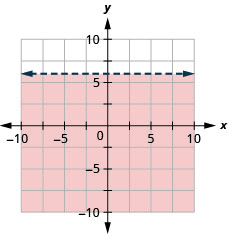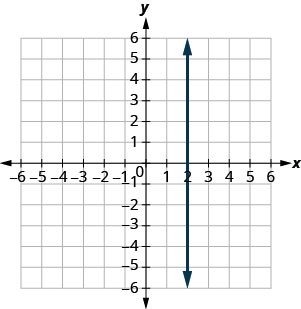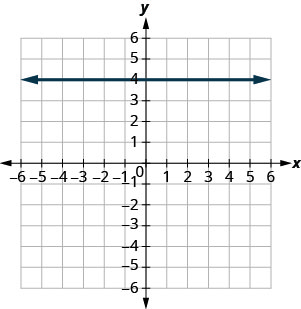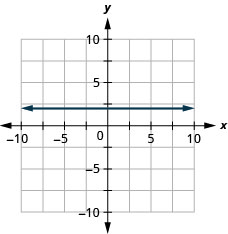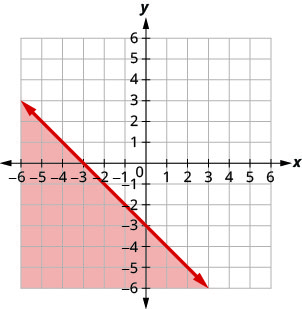Chapter 4 Review Exercises
Plot Points in a Rectangular Coordinate System
In the following exercises, plot each point in a rectangular coordinate system.
Exercise \(\PageIndex{1}\)
- (−1,−5)
- (−3,4)
- (2,−3)
- \(\left(1, \frac{5}{2}\right)\)
Exercise \(\PageIndex{2}\)
- (4,3)
- (−4,3)
- (−4,−3)
- (4,−3)
- Answer
-
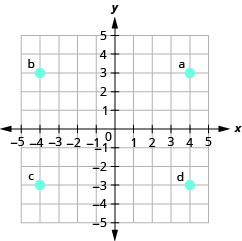
Exercise \(\PageIndex{3}\)
- (−2,0)
- (0,−4)
- (0,5)
- (3,0)
Exercise \(\PageIndex{4}\)
- \(\left(2, \frac{3}{2}\right)\)
- \(\left(3, \frac{4}{3}\right)\)
- \(\left(\frac{1}{3},-4\right)\)
- \(\left(\frac{1}{2},-5\right)\)
- Answer
-

Identify Points on a Graph
In the following exercises, name the ordered pair of each point shown in the rectangular coordinate system.
Exercise \(\PageIndex{5}\)
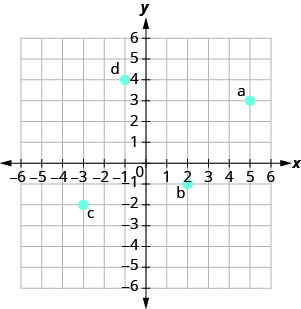
Exercise \(\PageIndex{6}\)
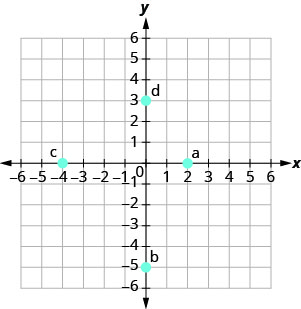
- Answer
-
a. (2,0)
b (0,−5)
c (−4.0)
d (0,3)
Verify Solutions to an Equation in Two Variables
In the following exercises, which ordered pairs are solutions to the given equations?
Exercise \(\PageIndex{7}\)
\(5x+y=10\)
- (5,1)
- (2,0)
- (4,−10)
Exercise \(\PageIndex{8}\)
\(y=6x−2\)
- (1,4)
- \(\left(\frac{1}{3}, 0\right)\)
- (6,−2)
- Answer
-
1, 2
Complete a Table of Solutions to a Linear Equation in Two Variables
In the following exercises, complete the table to find solutions to each linear equation.
Exercise \(\PageIndex{9}\)
\(y=4 x-1\)
Exercise \(\PageIndex{10}\)
\(y=-\frac{1}{2} x+3\)
- Answer
-
| x |
y |
(x,y) |
| 0 |
3 |
(0,3) |
| 4 |
1 |
(4, 1) |
| −2 |
4 |
(−2,4) |
Exercise \(\PageIndex{11}\)
\(x+2 y=5\)
Exercise \(\PageIndex{12}\)
\(3x+2y=6\)
- Answer
-
| x |
y |
(x,y) |
| 0 |
−3 |
(0,−3) |
| 2 |
0 |
(2,0) |
| −2 |
−6 |
(−2,−6) |
Find Solutions to a Linear Equation in Two Variables
In the following exercises, find three solutions to each linear equation.
Exercise \(\PageIndex{13}\)
\(x+y=3\)
Exercise \(\PageIndex{14}\)
\(x+y=-4\)
- Answer
-
Answers will vary.
Exercise \(\PageIndex{15}\)
\(y=3 x+1\)
Exercise \(\PageIndex{16}\)
\(y=-x-1\)
- Answer
-
Answers will vary.
Recognize the Relation Between the Solutions of an Equation and its Graph
In the following exercises, for each ordered pair, decide:
- Is the ordered pair a solution to the equation?
- Is the point on the line?
Exercise \(\PageIndex{17}\)
\(y=−x+4\)
(0,4) (−1,3)
(2,2) (−2,6)
-
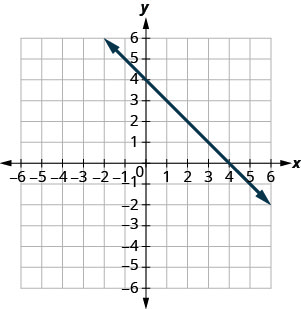
Exercise \(\PageIndex{18}\)
\(y=\frac{2}{3} x-1\)
\((0,-1) (3,1)\)
\((-3,-3) (6,4)\)
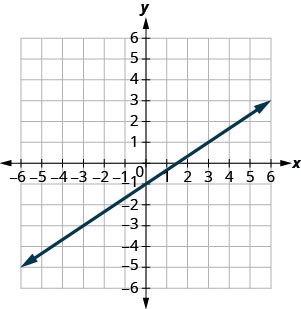
- Answer
-
- yes; yes
- yes; no
Graph a Linear Equation by Plotting Points
In the following exercises, graph by plotting points.
Exercise \(\PageIndex{19}\)
\(y=4x-3\)
Exercise \(\PageIndex{20}\)
\(y=-3x\)
- Answer
-
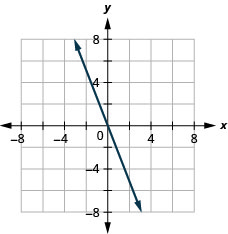
Exercise \(\PageIndex{21}\)
\(y=\frac{1}{2} x+3\)
Exercise \(\PageIndex{22}\)
\(x-y=6\)
- Answer
-
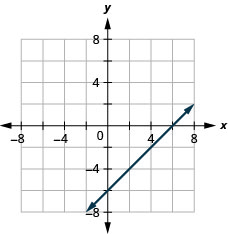
Exercise \(\PageIndex{23}\)
\(2x+y=7\)
Exercise \(\PageIndex{24}\)
\(3x-2y=6\)
- Answer
-

Graph Vertical and Horizontal lines
In the following exercises, graph each equation.
Exercise \(\PageIndex{25}\)
\(y=-2\)
Exercise \(\PageIndex{26}\)
\(x=3\)
- Answer
-
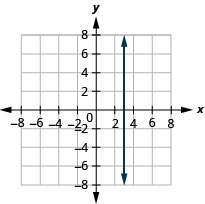
In the following exercises, graph each pair of equations in the same rectangular coordinate system.
Exercise \(\PageIndex{27}\)
\(y=-2 x\) and \(y=-2\)
Exercise \(\PageIndex{28}\)
\(y=\frac{4}{3} x\) and \(y=\frac{4}{3}\)
- Answer
-
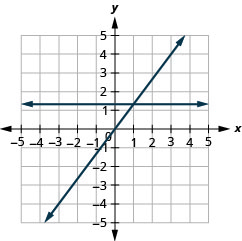
Identify the \(x\)- and \(y\)-Intercepts on a Graph
In the following exercises, find the \(x\)- and \(y\)-intercepts.
Exercise \(\PageIndex{29}\)
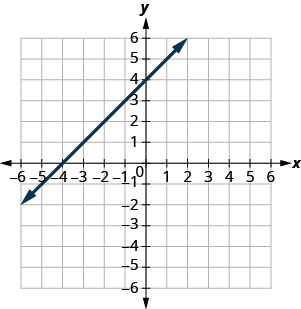
Exercise \(\PageIndex{30}\)
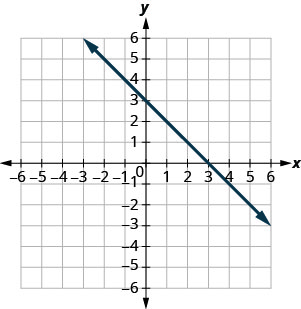
- Answer
-
\((3,0)\) and \((0,3)\)
Find the\(x\)- and \(y\)-Intercepts from an Equation of a Line
In the following exercises, find the intercepts of each equation.
Exercise \(\PageIndex{31}\)
\(x+y=5\)
Exercise \(\PageIndex{32}\)
\(x-y=-1\)
- Answer
-
\((-1,0),(0,1)\)
Exercise \(\PageIndex{33}\)
\(x+2y=6\)
Exercise \(\PageIndex{34}\)
\(2x+3y=12\)
- Answer
-
\((6,0),(0,4)\)
Exercise \(\PageIndex{35}\)
\(y=\frac{3}{4} x-12\)
Exercise \(\PageIndex{36}\)
\(y=3x\)
- Answer
-
\((0,0)\)
Graph a Line Using the Intercepts
In the following exercises, graph using the intercepts.
Exercise \(\PageIndex{37}\)
\(-x+3y=3\)
Exercise \(\PageIndex{38}\)
\(x+y=-2\)
- Answer
-
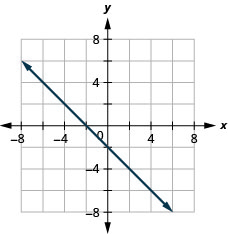
Exercise \(\PageIndex{39}\)
\(x-y=4\)
Exercise \(\PageIndex{40}\)
\(2x-y=5\)
- Answer
-
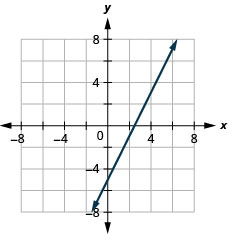
Exercise \(\PageIndex{41}\)
\(2x-4y=8\)
Exercise \(\PageIndex{42}\)
\(y=2x\)
- Answer
-
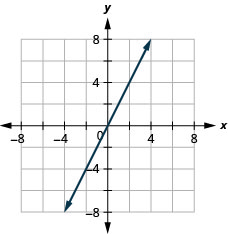
Use Geoboards to Model Slope
In the following exercises, find the slope modeled on each geoboard.
Exercise \(\PageIndex{43}\)
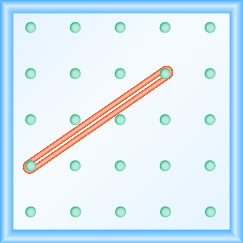
Exercise \(\PageIndex{44}\)
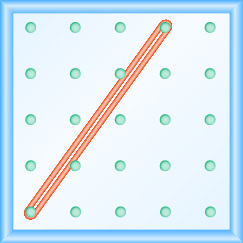
- Answer
-
\(\frac{4}{3}\)
Exercise \(\PageIndex{45}\)
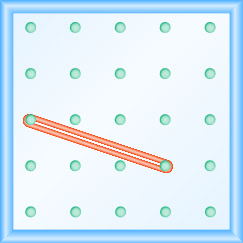
Exercise \(\PageIndex{46}\)
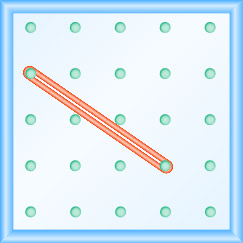
- Answer
-
\(-\frac{2}{3}\)
Exercise \(\PageIndex{47}\)
\(\frac{1}{3}\)
Exercise \(\PageIndex{48}\)
\(\frac{3}{2}\)
- Answer
-
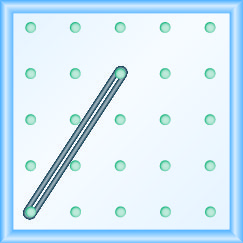
Exercise \(\PageIndex{49}\)
\(-\frac{2}{3}\)
Exercise \(\PageIndex{50}\)
\(-\frac{1}{2}\)
- Answer
-
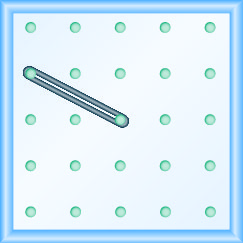
Use \(m=\frac{\text { rise }}{\text { run }}\) to find the Slope of a Line from its Graph
In the following exercises, find the slope of each line shown.
Exercise \(\PageIndex{51}\)
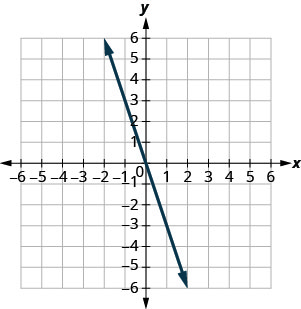
Exercise \(\PageIndex{52}\)
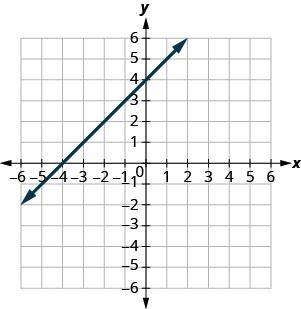
- Answer
-
1
Exercise \(\PageIndex{53}\)
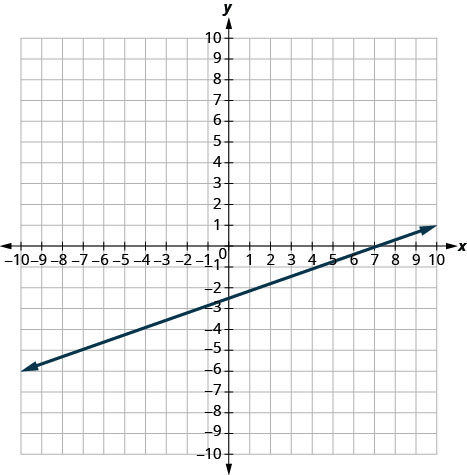
Exercise \(\PageIndex{54}\)
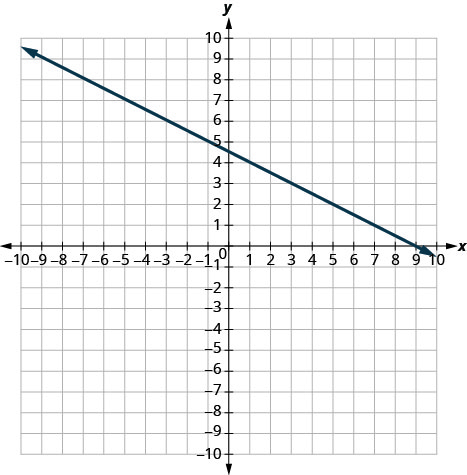
- Answer
-
\(-\frac{1}{2}\)
Find the Slope of Horizontal and Vertical Lines
In the following exercises, find the slope of each line.
Exercise \(\PageIndex{55}\)
\(y=2\)
Exercise \(\PageIndex{56}\)
\(x=5\)
- Answer
-
undefined
Exercise \(\PageIndex{57}\)
\(x=-3\)
Exercise \(\PageIndex{58}\)
\(y=-1\)
- Answer
-
0
Use the Slope Formula to find the Slope of a Line between Two Points
In the following exercises, use the slope formula to find the slope of the line between each pair of points.
Exercise \(\PageIndex{59}\)
\((-1,-1),(0,5)\)
Exercise \(\PageIndex{60}\)
\((3,5),(4,-1)\)
- Answer
-
−6
Exercise \(\PageIndex{61}\)
\((-5,-2),(3,2)\)
Exercise \(\PageIndex{62}\)
\((2,1),(4,6)\)
- Answer
-
\(\frac{5}{2}\)
Graph a Line Given a Point and the Slope
In the following exercises, graph each line with the given point and slope.
Exercise \(\PageIndex{63}\)
\((2,-2) ; \quad m=\frac{5}{2}\)
Exercise \(\PageIndex{64}\)
\((-3,4) ; \quad m=-\frac{1}{3}\)
- Answer
-
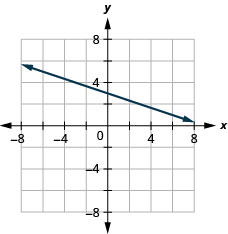
Exercise \(\PageIndex{65}\)
\(x\) -intercept \(-4 ; \quad m=3\)
Exercise \(\PageIndex{66}\)
\(y\) -intercept \(1 ; \quad m=-\frac{3}{4}\)
- Answer
-
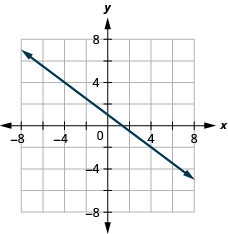
Solve Slope Applications
In the following exercises, solve these slope applications.
Exercise \(\PageIndex{67}\)
The roof pictured below has a rise of \(10\) feet and a run of \(15\) feet. What is its slope?
-
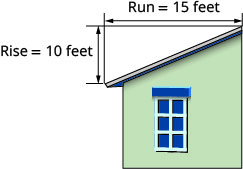
Exercise \(\PageIndex{68}\)
A mountain road rises \(50\) feet for a \(500\)-foot run. What is its slope?
- Answer
-
\(\frac{1}{10}\)
Recognize the Relation Between the Graph and the Slope–Intercept Form of an Equation of a Line
In the following exercises, use the graph to find the slope and y-intercept of each line. Compare the values to the equation \(y=mx+b\).
Exercise \(\PageIndex{69}\)

\(y=4x−1\)
Exercise \(\PageIndex{70}\)
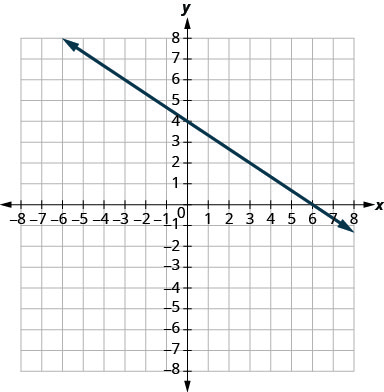
\(y=-\frac{2}{3} x+4\)
- Answer
-
slope \(m=-\frac{2}{3}\) and \(y\)-intercept \((0,4)\)
Identify the Slope and y-Intercept from an Equation of a Line
In the following exercises, identify the slope and \(y\)-intercept of each line.
Exercise \(\PageIndex{71}\)
\(y=-4 x+9\)
Exercise \(\PageIndex{72}\)
\(y=\frac{5}{3} x-6\)
- Answer
-
\(\frac{5}{3} ;(0,-6)\)
Exercise \(\PageIndex{73}\)
\(5x+y=10\)
Exercise \(\PageIndex{74}\)
\(4x-5y=8\)
- Answer
-
\(\frac{4}{5} ;\quad \left(0,-\frac{8}{5}\right)\)
Graph a Line Using Its Slope and Intercept
In the following exercises, graph the line of each equation using its slope and \(y\)-intercept.
Exercise \(\PageIndex{75}\)
\(y=2x+3\)
Exercise \(\PageIndex{76}\)
\(y=-x-1\)
- Answer
-
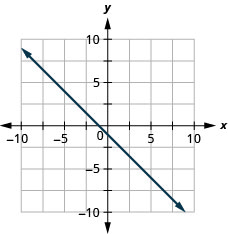
Exercise \(\PageIndex{77}\)
\(y=-\frac{2}{5} x+3\)
Exercise \(\PageIndex{78}\)
\(4x-3y=12\)
- Answer
-
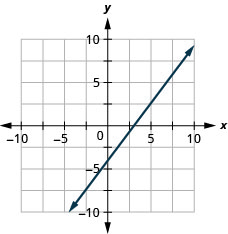
In the following exercises, determine the most convenient method to graph each line.
Exercise \(\PageIndex{79}\)
\(x=5\)
Exercise \(\PageIndex{80}\)
\(y=-3\)
- Answer
-
horizontal line
Exercise \(\PageIndex{81}\)
\(2x+y=5\)
Exercise \(\PageIndex{82}\)
\(x-y=2\)
- Answer
-
intercepts
Exercise \(\PageIndex{83}\)
\(y=x+2\)
Exercise \(\PageIndex{84}\)
\(y=\frac{3}{4} x-1\)
- Answer
-
plotting points
Graph and Interpret Applications of Slope–Intercept
Exercise \(\PageIndex{85}\)
Katherine is a private chef. The equation \(C=6.5m+42\) models the relation between her weekly cost, \(C\), in dollars and the number of meals, \(m\), that she serves.
- Find Katherine’s cost for a week when she serves no meals.
- Find the cost for a week when she serves \(14\) meals.
- Interpret the slope and \(C\)-intercept of the equation.
- Graph the equation.
Exercise \(\PageIndex{86}\)
Marjorie teaches piano. The equation \(P=35h−250\) models the relation between her weekly profit, \(P\), in dollars and the number of student lessons, \(s\), that she teaches.
- Find Marjorie’s profit for a week when she teaches no student lessons.
- Find the profit for a week when she teaches \(20\) student lessons.
- Interpret the slope and \(P\)-intercept of the equation.
- Graph the equation.
- Answer
-
- \(−$250\)
- \($450\)
- The slope, \(35\), means that Marjorie’s weekly profit, \(P\), increases by \($35\) for each additional student lesson she teaches. The \(P\)-intercept means that when the number of lessons is \(0\), Marjorie loses \($250\).
-
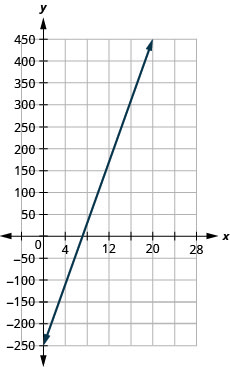
Use Slopes to Identify Parallel Lines
In the following exercises, use slopes and \(y\)-intercepts to determine if the lines are parallel.
Exercise \(\PageIndex{87}\)
\(4x-3y=-1 ; \quad y=\frac{4}{3} x-3\)
Exercise \(\PageIndex{88}\)
\(2 x-y=8 ; \quad x-2 y=4\)
- Answer
-
not parallel
Use Slopes to Identify Perpendicular Lines
In the following exercises, use slopes and y-intercepts to determine if the lines are perpendicular.
Exercise \(\PageIndex{89}\)
\(y=5x-1 ; \quad 10x+2y=0\)
Exercise \(\PageIndex{90}\)
\(3x-2y=5 ; \quad 2x+3y=6\)
- Answer
-
perpendicular
Find an Equation of the Line Given the Slope and y-Intercept
In the following exercises, find the equation of a line with given slope and \(y\)-intercept. Write the equation in slope–intercept form.
Exercise \(\PageIndex{91}\)
slope \(\frac{1}{3}\) and \(y\)-intercept \((0,-6)\)
Exercise \(\PageIndex{92}\)
slope \(-5\) and \(y\)-intercept \((0,-3)\)
- Answer
-
\(y=-5x-3\)
Exercise \(\PageIndex{93}\)
slope \(0\) and \(y\)-intercept \((0,4)\)
Exercise \(\PageIndex{94}\)
slope \(-2\) and \(y\)-intercept \((0,0)\)
- Answer
-
\(y=-2x\)
In the following exercises, find the equation of the line shown in each graph. Write the equation in slope–intercept form.
Exercise \(\PageIndex{95}\)
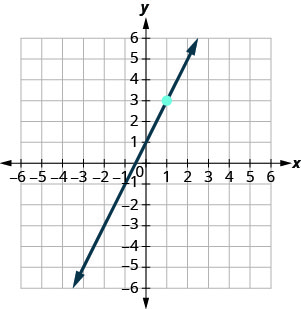
Exercise \(\PageIndex{96}\)
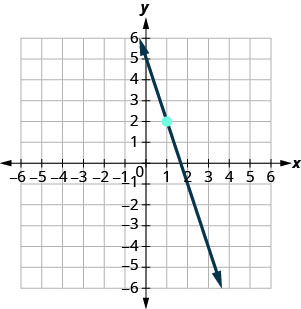
- Answer
-
\(y=-3x+5\)
Exercise \(\PageIndex{97}\)
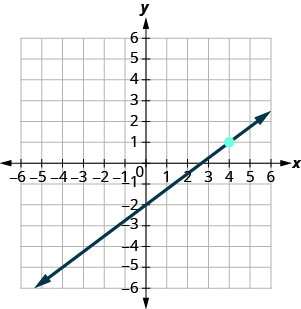
Exercise \(\PageIndex{98}\)
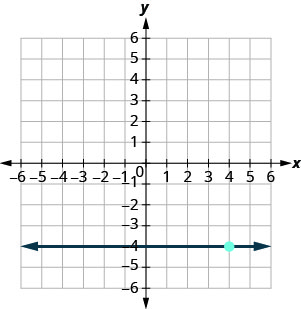
- Answer
-
\(y=-4\)
Find an Equation of the Line Given the Slope and a Point
In the following exercises, find the equation of a line with given slope and containing the given point. Write the equation in slope–intercept form.
Exercise \(\PageIndex{99}\)
\(m=-\frac{1}{4},\) point \((-8,3)\)
Exercise \(\PageIndex{100}\)
\(m=\frac{3}{5},\) point \((10,6)\)
- Answer
-
\(y=\frac{3}{5} x\)
Exercise \(\PageIndex{101}\)
Horizontal line containing \((-2,7)\)
Exercise \(\PageIndex{102}\)
\(m=-2,\) point \((-1,-3)\)
- Answer
-
\(y=-2x-5\)
Find an Equation of the Line Given Two Points
In the following exercises, find the equation of a line containing the given points. Write the equation in slope–intercept form.
Exercise \(\PageIndex{103}\)
\((2,10)\) and \((-2,-2)\)
Exercise \(\PageIndex{104}\)
\((7,1)\) and \((5,0)\)
- Answer
-
\(y=\frac{1}{2} x-\frac{5}{2}\)
Exercise \(\PageIndex{105}\)
\((3,8)\) and \((3,-4)\)
Exercise \(\PageIndex{106}\)
\((5,2)\) and \((-1,2)\)
- Answer
-
\(y=2\)
Find an Equation of a Line Parallel to a Given Line
In the following exercises, find an equation of a line parallel to the given line and contains the given point. Write the equation in slope–intercept form.
Exercise \(\PageIndex{107}\)
line \(y=-3x+6,\) point \((1,-5)\)
Exercise \(\PageIndex{108}\)
line \(2x+5y=-10,\) point \((10,4)\)
- Answer
-
\(y=-\frac{2}{5} x+8\)
Exercise \(\PageIndex{109}\)
line \(x=4,\) point \((-2,-1)\)
Exercise \(\PageIndex{110}\)
line \(y=-5,\) point \((-4,3)\)
- Answer
-
\(y=3\)
Find an Equation of a Line Perpendicular to a Given Line
In the following exercises, find an equation of a line perpendicular to the given line and contains the given point. Write the equation in slope–intercept form.
Exercise \(\PageIndex{111}\)
line \(y=-\frac{4}{5} x+2,\) point \((8,9)\)
Exercise \(\PageIndex{112}\)
line \(2x-3y=9,\) point \((-4,0)\)
- Answer
-
\(y=-\frac{3}{2} x-6\)
Exercise \(\PageIndex{113}\)
line \(y=3,\) point \((-1,-3)\)
Exercise \(\PageIndex{114}\)
line \(x=-5\) point \((2,1)\)
- Answer
-
\(y=1\)
Verify Solutions to an Inequality in Two Variables
In the following exercises, determine whether each ordered pair is a solution to the given inequality.
Exercise \(\PageIndex{115}\)
Determine whether each ordered pair is a solution to the inequality \(y<x−3\):
- \((0,1)\)
- \((−2,−4)\)
- \((5,2)\)
- \((3,−1)\)
- \((−1,−5)\)
Exercise \(\PageIndex{116}\)
Determine whether each ordered pair is a solution to the inequality \(x+y>4\):
- \((6,1)\)
- \((−3,6)\)
- \((3,2)\)
- \((−5,10)\)
- \((0,0)\)
- Answer
-
- yes
- no
- yes
- yes
- no
Recognize the Relation Between the Solutions of an Inequality and its Graph
In the following exercises, write the inequality shown by the shaded region.
Exercise \(\PageIndex{117}\)
Write the inequality shown by the graph with the boundary line \(y=−x+2\).
-
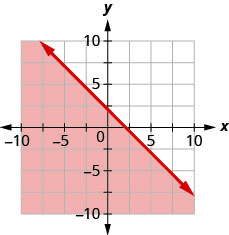
Exercise \(\PageIndex{118}\)
Write the inequality shown by the graph with the boundary line \(y=\frac{2}{3} x-3\)
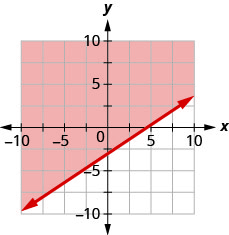
- Answer
-
\(y>\frac{2}{3} x-3\)
Exercise \(\PageIndex{119}\)
Write the inequality shown by the shaded region in the graph with the boundary line \(x+y=−4\).
-
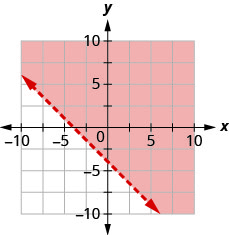
Exercise \(\PageIndex{120}\)
Write the inequality shown by the shaded region in the graph with the boundary line \(x−2y=6\).

- Answer
-
\(x-2 y \geq 6\)
Graph Linear Inequalities
In the following exercises, graph each linear inequality.
Exercise \(\PageIndex{121}\)
Graph the linear inequality \(y>\frac{2}{5} x-4\)
Exercise \(\PageIndex{122}\)
Graph the linear inequality \(y \leq-\frac{1}{4} x+3\)
- Answer
-
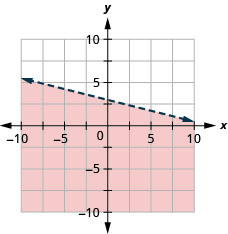
Exercise \(\PageIndex{123}\)
Graph the linear inequality \(x-y \leq 5\)
Exercise \(\PageIndex{124}\)
Graph the linear inequality \(3 x+2 y>10\)
- Answer
-
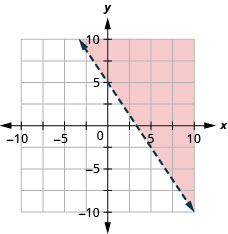
Exercise \(\PageIndex{125}\)
Graph the linear inequality \(y \leq-3 x\)
Exercise \(\PageIndex{126}\)
Graph the linear inequality \(y<6\)
- Answer
-
